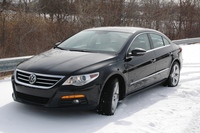2009 Volkswagen CC Review
MORE: Compare Volkswagen Specs and Prices-Volkswagen Buyers Guide
2009 VOLKSWAGEN CC VR6 4MOTION
Sleekest VW Yet
By Steve Purdy
TheAutoChannel.com
Detroit Bureau
 |
It’s only the overall shape, though, that says MB – the details say up-scale VW.
What do you suppose the CC stands for? Well, it means “Comfort Coupe,” they say. What a silly name. Our friends at VW are playing fast and loose with the semantics here. It certainly is not a coupe if it has four doors and a B-pillar, now is it? It is certainly comfortable, I must say - just a little tight getting in and out for me. (More on that later.) To be fair, VW is not the first to stretch this “coupe” definition. Underneath it is purely Passat mid-size sedan - a competent, fun-to-drive sedan with German design and engineering.
CC is just a sexed-up version of Passat. The blacked-out B-Pilar and window frames make it look a bit like a coupe, I guess, and certainly add to the more dramatic appearance. We might even call it a classic 2+2, since it is a 4-passenger sedan with a hard console separating the rear passengers. It’s comfortably roomy inside at all passenger positions and the trunk is roomy as well. It would be a great traveling car for four folks at a time.
Cruising down the road we can barely feel and hear a subtle thrum coming from under the hood. It’s the 3.6-liter, 280-horse, 24-valve, narrow-angle VR6 sporting a dual exhaust with sporty baffling. The substantial 265 lbs-ft of torque provides plenty of grunt for this 3,300-pound car. VW claims a 0-to-60 mph time of 6.6 seconds. The EPA rates the VR6 at 17-mpg in the city and 25-mpg on the highway. An impressive .28 coefficient of drag contributes to the good highway number. And an 18.5-gallon fuel tank makes for good range.
The only other engine available in the CC on this side of the pond is the GTI’s smooth, sophisticated 2.0-liter turbo gasoline 4-cylinder making a tad over 200 horsepower. It will do 0-to-60 in 7.4 seconds. With this little engine you can have a six speed stick or the universal Tiptronic automatic, though you can’t have the quick-shifting dual-clutch DSG transmission. Too bad.
We have the smooth, silent six-speed Tiptronic (only trans available with the V6) on our tester to get the power to the road, and it does an excellent job. Just for fun small paddle shifters are mounted to the steering wheel. Under modest throttle shifts are so smooth they are barely perceptible. We also have the trusted 4Motion all-wheel drive, essentially the wonderfully competent Audi Quattro system. You can’t go wrong with that.
 |
This is a pleasant car on the road with just a few niggles. First, the cruise control is precise and quick to set but bumping the speed up or down results in 5-mph of range at a time. It should go up and down 1 mph at a time. Second, the dash lights don’t turn down enough at night. And, why do you suppose the radio turns itself down when we shut the car off so that I always have to turn it up again when restart and head out on another adventure? Finally, I’m not sure what the advantage of the push-the-fob-into-the-slot system is over a conventional key. The fob has a hard metal loop on it that hurts the finger. Let’s just use a push button start – the kind where you leave the fob in your pocket, like many other luxury, and some common makes, do it.
The CC comes in five iterations - two “Sport” and one “Luxury” model starting at $27,100. Those three come with the 4-cylinder, 2.0-liter turbo engine. Then there are the VR6 Sport (front-wheel drive) and VR6 4Motion (all-wheel drive) with the V6 engine. Those two start at $38,300 and $39,300 respectively. That’s a pretty hefty premium for a few extra horsepower and about a second better 0-to-60 time, and a bit more generous content.
Our well-equipped test car had only the Technology Package as an option (navigation system and rear view camera) for $2,640. The bottom line, with a $690 destination charge, is $42,630 – not cheap for sure. But the list of standard features on this top-of-the-line model is impressive like: Bi-Xemon adaptive headlights, nice leather, dual-zone climate controls, rain-sensing wipers, 18-inch alloy wheels with self-sealing all-season tires, full chassis dynamics, and everything else you’d expect from an up-scale German car.
The new vehicle warranty covers the CC for 3 years or 36,000 miles and the powertrain is covered for 5 years or 60,000 miles. Corrosion protection is for 12 years and scheduled maintenance is free for the first 3 years or 36,000 miles.
VW just reported profits up substantially for 2008, when the entire industry was suffering record losses. How did they do that? Well, the CC may give some insight.
MORE: Compare Volkswagen Specs and Prices-Volkswagen Buyers Guide
© Steve Purdy, Shunpiker Productions, All Rights Reserved



